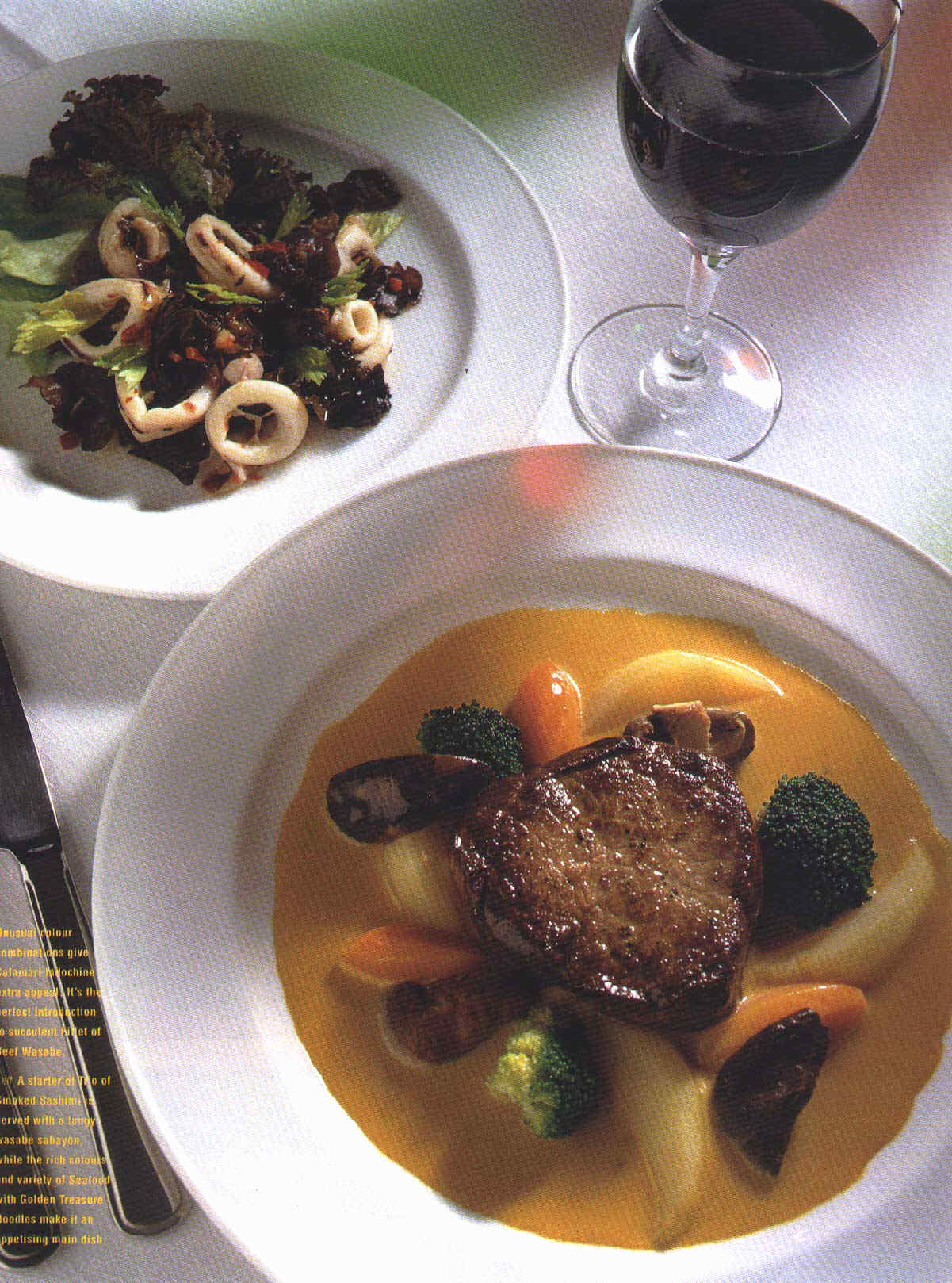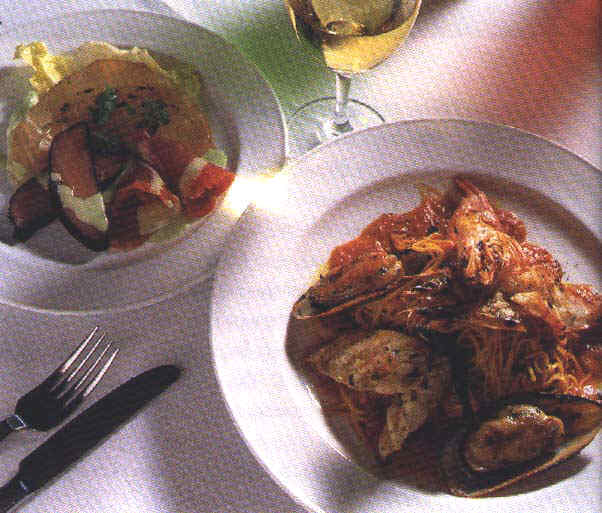| RESTAURANTS | |
 |
|
MANIFESTO By Emma Warlow : Apartment Living June | July 1996
Looking towards the curve-fronted bar at the entrance of the restaurant, with its luminous empty bottle display and gentle lighting courtesy of bronze star lanterns from Mexico
Unusual color combinations give Calamari Indochine extra appeal. It's the perfect introduction to succulent Fillet of Beef Wasabe
A starter of Trio of Smoked Sashimi is served with tangy wasabe sabayon, while the rich colors and variety of Seafood with Golden Treasure Noodles make it an appetizing main dish |
R E N A I S S A N C E S P L E N D O R Manifesto [The Spot on The Hub] is an unusual restaurant for many reasons. The chief among these is probably its location. The Science Park is very far from being the hub of Singapore, and to discover such a sophisticated and original eating place there is a considerable surprise. Co-owner Andrew Lian of The Food Exchange was originally approached by the Science Park administrators with an invitation to open a second branch of his successful Blue Ginger Restaurant in Tanjong Pagar, in the uncompromisingly large, curved slice of space on the second floor of the Science Park's Hub. 'At the time, Blue Ginger had only been going for about five months, so it seemed rather early to start diluting its impact with another branch', he explains. 'So I persuaded them to let me come up with an original concept, both in terms of food and appearance. For help with the latter, he turned to American architect Ed Poole of Poole Associates, whose imaginative Peranakan-themed work on Blue Ginger had proved so successful. They realized the venue cried out for some kind of scientific references, but they badly wanted to avoid the obvious: 'futuristic clinical coldness, test-tubes - the chemistry lab of the 21st century look'. The sheer scale of the space was also a factor, with huge floor to ceiling curved windows sweeping around the edge of the room. Instead of looking forward, Ed found his inspiration in the past. 'The Renaissance was a time of enormous human endeavor in every field', he explains. 'There was in particular an explosion of interest in the sciences, and everyone got involved. So we chose the great polymath Leonardo da Vinci as our representative of all scientists, and a concept was born'. Rich ochre and burnt umber shades call Italian frescos to mind, and the complex triangular-tiled floor is reminiscent of those in ancient churches. A giant fragment of the Mona Lisa is reproduced at the entrance to the restaurant and exquisitely executed giant charcoal drawings of other Leonardo masterpieces by Ed's colleague Willy Baet hang at intervals around the room - the most spectacular being his out-sized rendition of The Virgin of the Rocks. The terrazzo tiles were deliberately left unfinished to encourage an aged look, and their asymmetric patterning in black, cream and deep brown is convincingly haphazard. The room certainly has drama, but the secret of its impact lies mainly in its simplicity. Tables have plain white cloths and dark wood chairs; lighting is provided by candles floating on colored water in suitably scientific apothecary's jars, single bulbs suspended from wires over the window-side tables and a miasma of illumination from the pierced bronze star lanterns that hang above the bar and voluptuous 10m long curving banquette. 'We decided to keep the windows undressed', says Andrew. 'It's actually very nice to look at the greenery during the day, and at night the lights inside reflect off the dark panes'. To emphasize the weighty structure of the room, Ed left the ceiling and supporting pillars unfinished in raw concrete. There has been much comment about this brave step, 'When is it going to be finished'? being a recurring question. But the rawness is a clever foil to the gilt-framed charcoal drawings and adds greatly to the scene at night. Long sweeps of cotton cheesecloth drapes hung on slender metal ball bearing chains serve to break up the expanse of window, and as partitions between groups of tables - a gentle touch in an austere scheme. The budget for the design was tight, and the time allotted to complete it brief. Using inexpensive materials (for example the same leather that covers the seat of the banquette was reversed to look like suede for the back of it) and inciting the whole team to help made the difference. 'We all worked on the wall finish', Andrew recalls. 'We rubbed brown shoe polish over uneven Venetian plaster to get that distressed ochre color. And I picked up the Mexican lantern lights on a trip to Sydney - I saw them, they looked like Ed's sketches, so I bought them'. The whole job, from conception to completion took less than four months. The food, described by Andrew as 'a fusion of the best of western and eastern cooking', is as unusual and rewarding as the decor. Chef Patrick Ho combines his experience of haute cuisine at the Restaurant de France in Le Meridien Hotel with knowledge of local cuisine to create light, Asian-style variations on classic themes. So his menu includes appetizers like Trio of Smoked Sashimi, comprising slivers of green tea-smoked marlin, manguro and salmon wrapped seaweed with a wasabe and lemon sabayon, and the colorful Calamari Indochine - poached slices of squid with cloud's ear fungus tossed in a Vietnamese sweet chili lime dressing. His deliciously tangy mushroom soup is served with a rolled dumpling of deep-fried minced chicken and coriander, while the innovative Carpaccio of Beef with Water chestnut in Miso Soup arrives at your table in stages - the slivers of beef and chestnuts are drenched before your eyes with the Japanese broth, poured from a miniature teapot. Main course staples like Roast Tenderloin of Lamb with Asian Spices have survived the recent menu changes, but new comers include a spectacular concoction of Seafood with Golden Treasure Noodles - tiger prawns, mussels and fish slices topped with tomato salsa on homemade saffron noodles - and fillet of Beef Wasabe, a classic cut of beef pan-fried and served with Japanese horseradish in a hollandaise sauce. Footnote: Manifesto was sold in 1997, and is now under new management. The simple beauty of the space has been destroyed. Project Design Team : Poole Associates Private Limited Ed Poole, Andrew Jones, Marie Bogart, Rey Tadifa, Wong Kim Mei, Willy Baet e:mail contact@poole-associates.com T 65 | 6536 | 3928 X Contractor : Grandwork Interior Pte Ltd 150 Orchard Road, #03-12 Orchard Plaza Singapore 238841 T 65 | 6738 | 6898
Click images for larger view Photography : Peter Mealin
|

